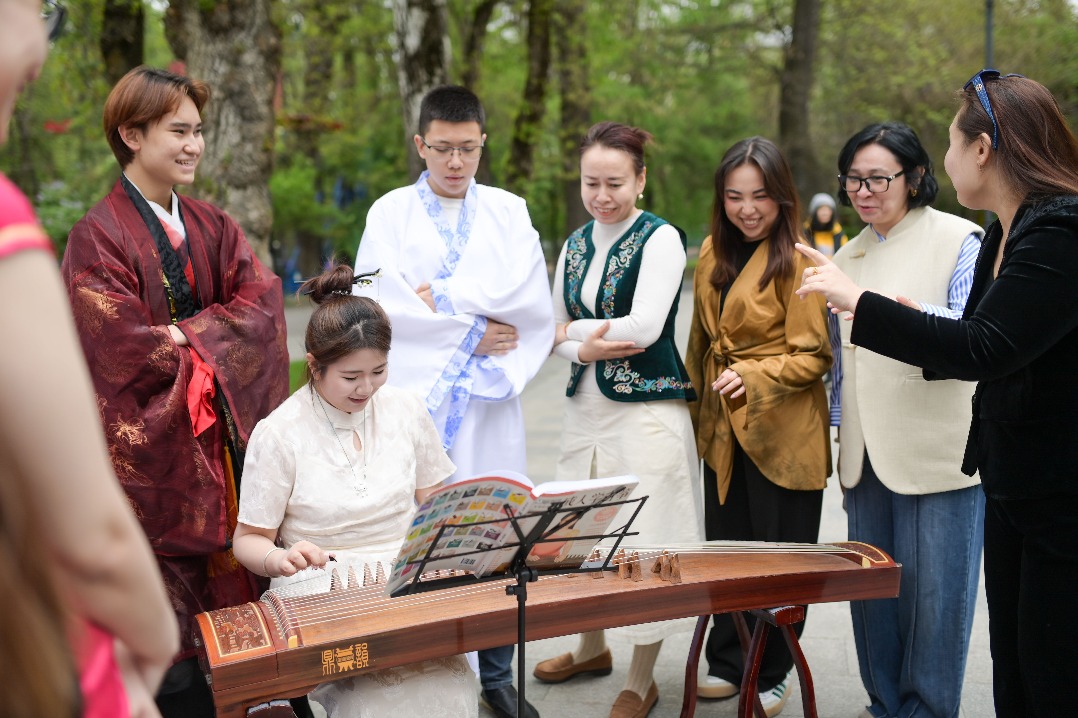A place in the sun far from home

Editor's Note: China is divided into as many culinary regions as there are different ethnic groups. Its geographical diversity and kaleidoscopic cultural profiles contribute to the unending banquet of flavors.
The culinary landscape in China has undergone tremendous changes in the past three decades. Not only has traditional cuisine been revived in an epicurean Renaissance, but homegrown chefs, too, have found their place in the sun.
They bask in the renewed pride of a culinary heritage that has survived time, war and revolution, and their personalities shine through in the new cult of the celebrity chefs.
| Tony Tang is executive Chinese chef at the Shangri-La Hotel in Tangshan, Hebei province. Provided to China Daily |
Chefs also are increasingly mobile.
Not only are they bringing Chinese cuisine to the world, but also regional cuisines to other parts of China.
In this, the globalization effect of international hotel chains plays a major part, just like the spread of Chinese brands.
Chef Tony Tang, 44, is an example of a chef far from home.
He is a native of Wuhan, Hubei province, but he grew up in Guangzhou, Guangdong province, where he entered apprenticeship in a Cantonese kitchen at an early age. He is trained in one of the best regional cuisines of China, with its emphasis on using the freshest ingredients and drawing out the best natural flavors.
As a practicing chef, he has worked in Shenzhen, Guangzhou, Zhuhai and Wuhan. He has also helmed kitchens in Beijing, Tianjin, Shenyang, Changchun and Tangshan.
That indicates a huge leap, geographically. Tang recently spoke with China Daily.
How do you adjust your cooking style in regions that are not familiar with Cantonese cooking?
Even if I am physically far away from where I learned to cook, I still enjoy planning and delivering gourmet meals to appreciative diners in Tangshan. (Tang is now the executive Chinese chef at the Shangri-La Hotel in Tangshan, Hebei province, 240 km from Beijing.)
But I am comfortable. To me, a chef's roots lie in his commitment to constantly learn, to constantly interact, to make more friends, to cook dishes that cut across regional barriers, to adapt to localized epicurean habits.
Although you are from Hubei, you trained as a chef in Guangdong province. What are the principles of Cantonese cooking?
Cantonese cooking is based on the ideal match of ingredients, the optimal pairing of food and sauce, and the seamless continuity of dishes served in the same meal. The most important success factor is to have the best and freshest material, so you can highlight the sweetest natural flavors.
Cantonese cuisine is always open to innovations, to new methods of cooking, to new ingredients. It moves with the times. In this new age of logistic ease and international influences, Cantonese cooks are using ingredients from all over China and experimenting with Western presentation, plating and even the latest cooking methods.
Do you think Cantonese cooking can be enjoyed throughout any city in China? What is your personal experience?
No, of course not. Traditional Cantonese cooking will not be easily accepted by every city. Each city has its own eating culture and palate preferences.
Perhaps it's because there is a growing emphasis to appreciate what you have locally, a new pursuit of regional specialties.
Adapting is a must. I often study local palate customs and eating habits and then temper the dishes according to these preferred tastes.
For example, in Shenyang, my team and I visited local farms to better understand the food produced in the region. We looked at the local eggs, the locally milled flour, seafood from Dalian, mushrooms from Changbaishan, and the variety of meats available. And in the process, we discovered the path of least resistance to a diner's stomach.
The Cantonese believe that food is medicine and medicine is food. We know you have a series of very healthy dishes. Can you tell us more?
I am happy to say that well-being in eating is now no more a regional characteristic limited to Cantonese cooking. It is a global movement, an international awareness, and it extends to more than food. Well-being includes attitude and exercise.
To eat healthily, we need a low-sugar, low-fat diet, so we generate a sense of hunger each new day.
To achieve a diet of well-being, you need:
1. Two to three liters of water a day.
2. A variety of five to six different vegetables, to a total of 1 to 1.5 kilograms.
3. A daily intake of 4 to 5 types of fruits, up to 500 to 750 grams.
4. About 250 g of rough grains daily.
5. Two hundred g of meat, variously chicken, beef or seafood.
6. An egg a day
7. Less salt and less oil in cooking.
The most memorable dish in a meal you prepared was the lemon chicken snow pear soup. Can you tell us more about how it is beneficial for the body?
This dish can quickly bring down high blood sugar levels and correct the PH levels in the body, stabilizing sugar levels.
As a chef in an international five-star hotel, where do you think Chinese cuisine is going? Are the clear classifications of the eight major cuisines in China slowing blurring boundaries? Do you think a new category or categories of Chinese cooking is emerging?
I feel that we are traveling on parallel roads. On one hand, many Chinese chefs are pursuing and studying traditional Chinese cuisines. But they are also constantly innovating, melding old and new. I think it's all about pleasing the public palate, where there is constant exchange and interaction between chef and diner.
To a certain extent, the eight major cuisines of China still retain their regional characteristics, much along the lines of trending eat-local movements.
But I also think new branches of Chinese cuisine will slowly grow apart and become more distinct, and they will reflect the mercurial tastes of grassroots eating. And these are the flavors that will be hard to replace and replicate.
Are non-Chinese diners beginning to understand more of what Chinese cuisine really is, now that they are coming to China more often, and Chinese cuisine is available worldwide?
China is a growing world power. Communication and media are becoming instant and powerful channels. It is easy for the global audience to understand what Chinese food is all about.
Chinese food has gone international. There are authentic Chinese restaurants in almost every major international city.
Chinese food, like Peking opera, is part of the cultural representation of China.
Many non-Chinese are taking an academic interest in all things Chinese, and likewise, they are beginning to understand the principles behind Chinese cooking.
A beneficial soup
Chicken and Snow Pear Soup With Lemon
1 chicken breast

1 large Chinese snow pear
2 slices of lemon
1 rice bowl of water
A little salt Wash and rinse skinned chicken breast. Wipe clean and place in a deep container with lid.
Peel and core the pear, but leave whole, or cut into half.
Add pear, lemon slices and water to chicken in the bowl. Season with a little salt.
Cover the container and steam over boiling water for 30 minutes.
Drink the soup and eat the pear and chicken breast instead of rice. This dish is best served for the evening meal.
(China Daily European Weekly 07/07/2017 page18)































